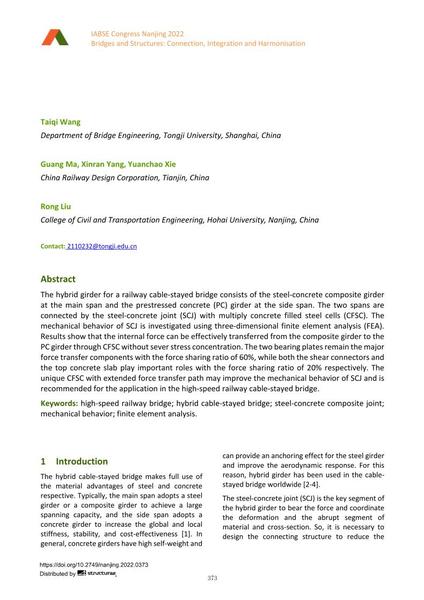Axial Force Transfer Mechanism of Steel-Concrete Joint in Hybrid Girder for Railway Cable-Stayed Bridge

|
|
|||||||||||
Bibliographic Details
| Author(s): |
Taiqi Wang
(Department of Bridge Engineering, Tongji University, Shanghai, China)
Guang Ma (China Railway Design Corporation, Tianjin, China) Xinran Yang (China Railway Design Corporation, Tianjin, China) Yuanchao Xie (China Railway Design Corporation, Tianjin, China) Rong Liu (College of Civil and Transportation Engineering, Hohai University, Nanjing, China) |
||||
|---|---|---|---|---|---|
| Medium: | conference paper | ||||
| Language(s): | English | ||||
| Conference: | IABSE Congress: Bridges and Structures: Connection, Integration and Harmonisation, Nanjing, People's Republic of China, 21-23 September 2022 | ||||
| Published in: | IABSE Congress Nanjing 2022 | ||||
|
|||||
| Page(s): | 373-379 | ||||
| Total no. of pages: | 7 | ||||
| DOI: | 10.2749/nanjing.2022.0373 | ||||
| Abstract: |
The hybrid girder for a railway cable-stayed bridge consists of the steel-concrete composite girder at the main span and the prestressed concrete (PC) girder at the side span. The two spans are connected by the steel-concrete joint (SCJ) with multiply concrete filled steel cells (CFSC). The mechanical behavior of SCJ is investigated using three-dimensional finite element analysis (FEA). Results show that the internal force can be effectively transferred from the composite girder to the PC girder through CFSC without sever stress concentration. The two bearing plates remain the major force transfer components with the force sharing ratio of 60%, while both the shear connectors and the top concrete slab play important roles with the force sharing ratio of 20% respectively. The unique CFSC with extended force transfer path may improve the mechanical behavior of SCJ and is recommended for the application in the high-speed railway cable-stayed bridge. |
||||
| Keywords: |
finite element analysis FEA mechanical behavior high-speed railway bridge hybrid cable-stayed bridge steel-concrete composite joint
|
||||
| Copyright: | © 2022 International Association for Bridge and Structural Engineering (IABSE) | ||||
| License: | This creative work is copyrighted material and may not be used without explicit approval by the author and/or copyright owner. |
||||


